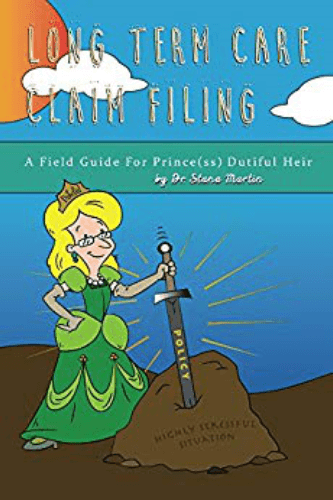Often people call us, confused as to why a long term care policy is not paying for the care their loved one needs.
Things you must know to Trigger your policy:
How it Triggers benefit.
Modern policies will trigger on daily living activities (ADL) and/or cognitive impairment.
Most policies will have 6 ADLs, older policies may have 5 or 4 listed in the policy Cognitive impairment requires a physician to diagnose a mental issue and that a patient undergo standardized tests for documentation. If documentation does not precisely match the policy, you may get a decline even though you have a legitimate claim. Be warned, the documentation requirements can be extensive… and everything must match with precision to the language in the contract.
Where it Triggers benefit.
Modern policies will usually pay in the full range of care options (home health care, assisted living, nursing home, etc.). But older policies may only pay in one or two of these areas. Further a “nursing home” is usually not equivalent to an “assisted living facility”. These are all defined very specifically in the contract. If you do not understand the definitions in the policy, we encourage you to get professional assistance in determining if the policy will pay for care where you want it to pay.
GETTING STARTED CHECKLIST
Long Term Care Claims
The process of filing on a long term care claim can seem overwhelming – learning new vocabulary terms, trying to master foreign concepts such as elimination period and hands-on assistance all the while you are desperately trying to make care decisions and manage you AND your parent’s lives…well it is no wonder that people get a little lost where to start.
So here is a check list that in order of what to do to start. By all means, call us here at Mrs. LTC, Inc if you have questions. We live for this around here!
Designate a “quarterback” – it is best if only one person handles the claim. Having multiple trying to each do some part is a recipe for disaster and lost information. This is one of the few times where “divide and conquer” doesn’t work that well.
Be sure the “Quarterback” has Durable Power of Attorney. All the information you are trying to access to get a claim filed is protected under HIPAA and/or other privacy laws. So if you are trying to file the claim, you will have to have authority to talk about medical and financial matters. And you will have to file it with the carrier, the doctor, the hospital, the rehab, and the care provider.
Call the carrier and ask them to clarify what the benefits are AND what level of medical need you have to prove to trigger the claim. TAKE NOTES. Ask lots of questions. Remember the person on the other end of the phone doesn’t have a time limit on the call. They should be patient and helpful in answering your (many) questions.
Change the address on file to your address. Once you initiate a claim there will be follow up correspondence of various types. You don’t want this going to the OLD address and possibly lost. You want it coming to your house.
Start a folder. You need one place to keep all the documents and correspondence on the claim – and there may be many before it is all a “done deal”.
Keep a contact log, marking down the date/time you do anything (like call the carrier or the doctor’s office), who you spoke to (“Cindy” or “Marissa” or….), and what information was exchanged. Your contact log helps you capture details and can function as a legal document if you ever need it.
Call the carrier some more. We know – it is annoying and you sit on hold and sometimes it seems like you are getting different info when you call back. But the only way to tackle this project is to make sure you know what you have to get to the carrier, make sure they GET it and call yet one more time to see what else is outstanding, then call to get it and then call the carrier again to see if they have everything…. You ride the merry go round until you get told they have everything they need to make a decision.
ACTIVITIES OF DAILY LIVING EXAMPLE:
Mrs. Brown fell and broke her hip. See when to the hospital and the rehab unit, and is released _ but she is still not able to be on her own. She still needs help, but the policy will ONLY cover if the help she needs meets the contract triggers. For example she can no longer drive or shop/cool for herself or manage her medications well, most people think it is time for the policy to pay for help. Well probably not… none of these are ‘activities of daily living’.
The ADLs are usually: bathing, toileting, transferring, continence, dressing, feeding. ‘Feeding’ the closest ADL, literally means: can you lift a fork of food to your mouth without assistance? So as of the date of her release from rehab, there is not a legitimate claim… yet. IF her needs continue to grow (as they often do), she may eventually need help with the ADLs listed and meet the contract triggers.
COGNITIVE IMPAIRMENT EXAMPLE:
Mr. Smith’s children notice at Thanksgiving that he just wasn’t ‘his old self’, but they couldn’t put their finger on the issue. Right before Christmas, the oldest daughter gets a call from the neighbor that Mr. Smith was on their doorstep at midnight and couldn’t find his house. Common sense says it’s time to trigger his policy to pay for care. However, the neighbor’s word will not be enough to get Mr. Smith’s polity to pay. Mr. Smith needs to be taken to the doctor and be diagnosed with cognitive failure through standardized testing measures. With the Doctor diagnosis of cognitive impairment in his medical records he would easily be claim eligible.
Questions?
Contact - Mrs. LTC
Long Term Care Claims & Insurance
Question about a Claim?
Shopping for coverage?









Leave A Comment
You must be logged in to post a comment.